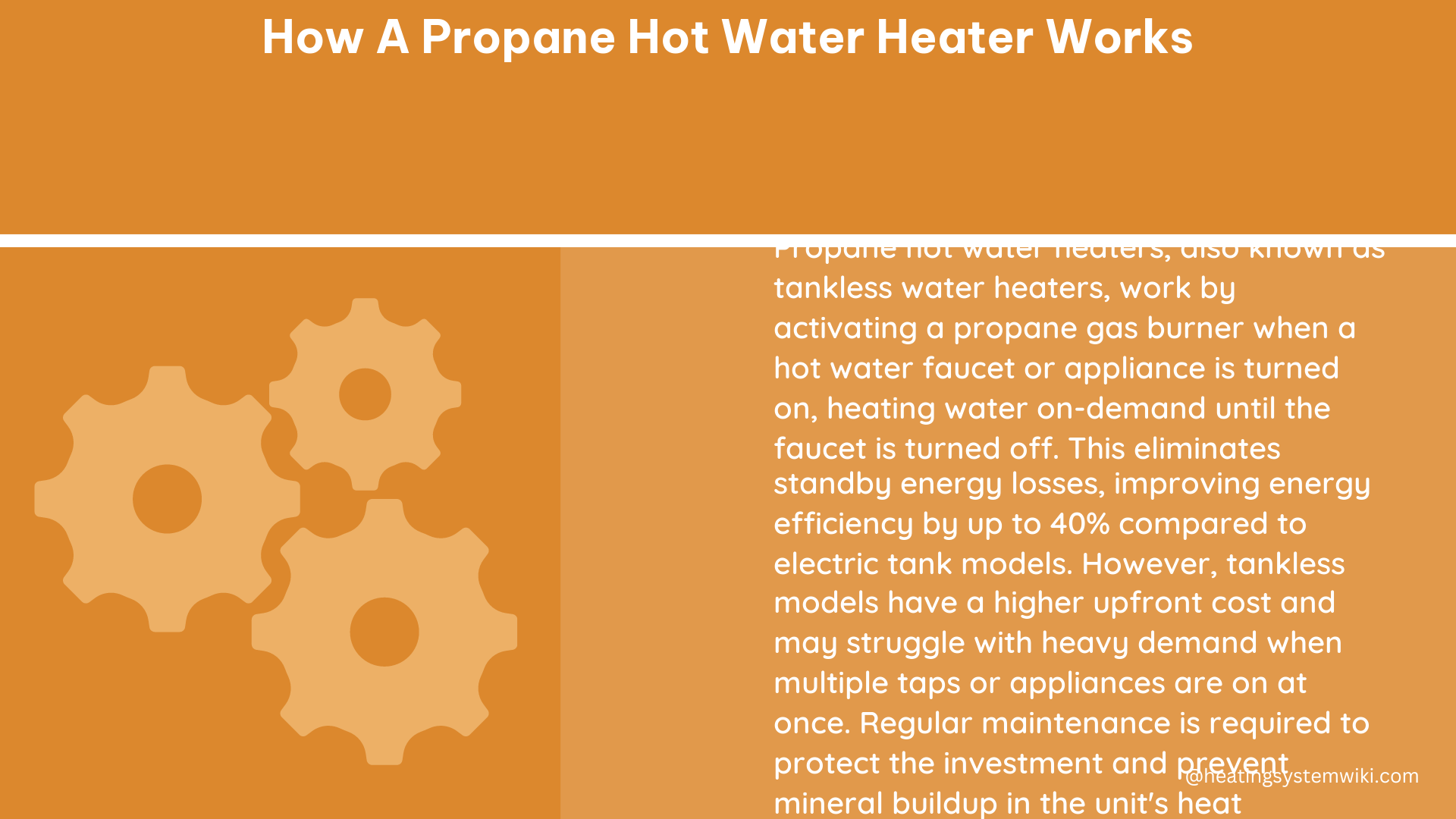A propane hot water heater is a reliable and efficient way to heat water for your home, using propane as the fuel source. The system works by burning the propane in a combustion chamber, which in turn heats the water stored in a tank. The temperature of the water is regulated by a thermostat, which controls the gas valve to maintain the desired temperature.
The Key Components of a Propane Hot Water Heater
-
Burner: This is the component where the propane is burned to produce heat. The burner is typically made of stainless steel or cast iron and is designed to ensure complete and efficient combustion of the propane.
-
Combustion Chamber: This is the area where the burner is located, and where the propane is burned to heat the water. The combustion chamber is typically made of heavy-duty steel or cast iron, and is designed to withstand the high temperatures generated during the combustion process.
-
Thermostat: This device regulates the temperature of the water in the tank by turning the gas valve on and off to maintain the desired temperature. The thermostat is typically a mechanical or electronic device that senses the water temperature and adjusts the gas flow accordingly.
-
Gas Valve: This valve controls the flow of propane to the burner. The gas valve is typically a solenoid-operated valve that opens and closes in response to signals from the thermostat.
-
Thermal Switch: This device protects against overheating by shutting off the gas valve if the temperature in the combustion chamber gets too high. This helps to prevent the water heater from overheating and potentially causing damage or a fire.
-
Thermocouple or Thermopile: These devices are used to sense the presence of a flame and to provide a signal to the gas valve to open. The thermocouple or thermopile is typically located near the burner and generates a small electrical current when exposed to the heat of the flame.
-
Draft Inducer Blower: This device is used in power vent models to push the exhaust through the vent, allowing the water heater to be placed virtually anywhere in the home. The draft inducer blower helps to ensure that the combustion gases are properly vented, which is important for safety and efficiency.
-
Pressure Switch: This device verifies that there is enough airflow for combustion. If the pressure switch detects insufficient airflow, it will shut off the gas valve to prevent incomplete combustion and potential safety hazards.
-
Flame Sensor: This device monitors the burner to confirm that there is a flame. If the flame sensor detects that the burner has gone out, it will shut off the gas valve to prevent the release of unburned propane.
How a Propane Hot Water Heater Works

When the thermostat detects that the water in the tank has cooled below the set temperature, it sends a signal to the gas valve to open. This allows propane to flow to the burner, where it is ignited by the hot surface ignitor.
The draft inducer blower then pulls fresh air into the burner, and the pressure switch verifies that there is enough airflow for combustion. The flame sensor monitors the burner to confirm that there is a flame, and the burner continues to run until the water in the tank reaches the set temperature.
Once the desired temperature is reached, the thermostat sends a signal to the gas valve to close, shutting off the flow of propane to the burner. The draft inducer blower will continue to run for several minutes after the burner shuts off to purge the system of exhaust gases.
One of the key advantages of a propane hot water heater is that it can be used during power outages, as long as there is a supply of propane. This is because the pilot light and thermocouple or thermopile can operate without electricity. However, if the water heater is a power vent model, it will require electricity to operate the draft inducer blower and pressure switch.
In terms of energy efficiency, propane hot water heaters are generally more efficient than electric models, as they can heat water more quickly and with less energy loss. However, they do require regular maintenance to ensure that they are operating safely and efficiently.
Maintenance and Safety Considerations
To ensure the safe and efficient operation of a propane hot water heater, it is important to perform regular maintenance. This includes:
- Checking the burner and combustion chamber for any signs of wear or damage
- Cleaning the burner and combustion chamber to remove any debris or soot buildup
- Checking the thermostat and gas valve to ensure they are functioning properly
- Inspecting the venting system to ensure it is clear and unobstructed
- Testing the safety devices, such as the thermal switch and flame sensor, to ensure they are working correctly
It is also important to follow all safety guidelines when operating a propane hot water heater, such as ensuring proper ventilation, never using the water heater in an enclosed space, and never attempting to repair or modify the system without the assistance of a qualified professional.
By understanding how a propane hot water heater works and performing regular maintenance, you can ensure that your home has a reliable and efficient source of hot water for years to come.
